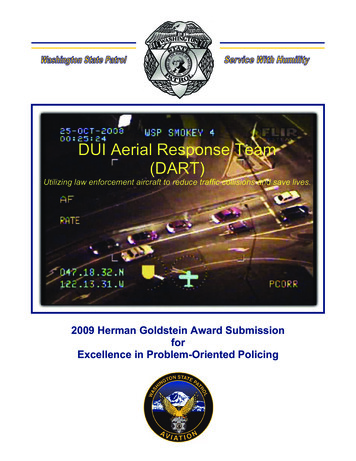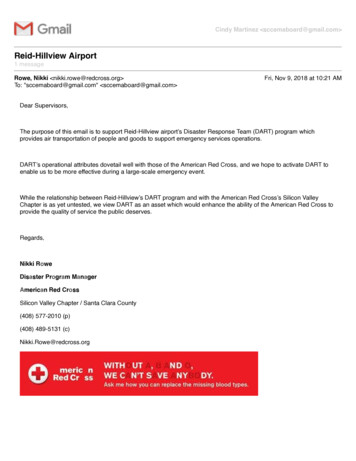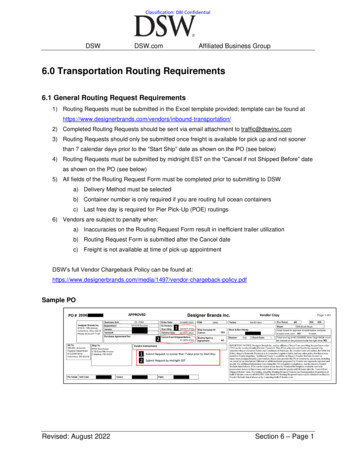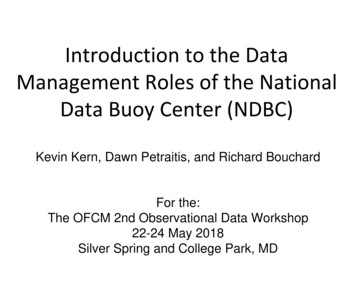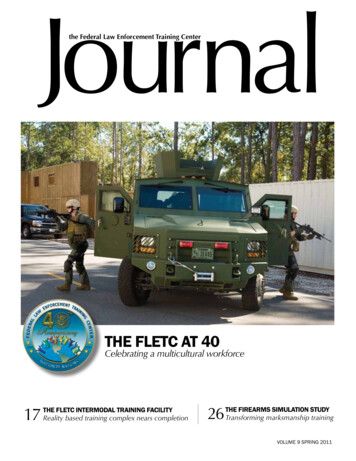
Transcription
Journalthe Federal Law Enforcement Training CenterTHE FLETC AT 40Celebrating a multicultural workforce17THE FLETC INTERMODAL TRAINING FACILITYReality based training complex nears completionFIREARMS SIMULATION STUDY26 THETransforming marksmanship trainingVOLUME 9 SPRING 2011
FIREARMS SIMULATION STUDYSTEVE HAWTHORNE and TERRY WOLLERT, Ph.D.Training InnovationRODNEY BURNETT and KEVIN ERDMIERFirearms26FLETC JOURNAL SPRING 2011
Just about everyone would agree that technology continues to transform how we live – from cell phones that link to theweb, to the laptops and networks that enable us to communicate, work, and even be entertained. The use of technologyand graphic simulation programs can be large in scale, such as multi-million dollar weapon system trainers for militarypilots, to the everyday Xboxes , PlayStations , and Wiis that entertain us with simulations of military operations,sports, and rock bands. Since 2007, the Federal Law Enforcement Training Center (FLETC) has been using technologyto enhance student learning through the use of driving and marine simulators. More recently, the Avatar Based InterviewSimulator (ABIS) is being studied as a viable training tool for teaching students to conduct an interview using thefive-step process they are taught in class. Even the Firearms Division (FAD) uses laser handguns and branching videosto teach the Judgment Pistol Shooting Course. Most recently, the FLETC explored using simulation to teach basicmarksmanship shooting skills by conducting a Firearms Simulation study.FLETC JOURNAL SPRING 201127
.a majoradvantage overregular dry fire isthat the Laser Shotsystem providesimmediatefeedback as toshot placement.FLETC marksmanship instructors coach basic students using the Laser Shot simulation laser handgunduring the Firearms Simulation Study.AT THE FLETC a basic student’sfirst exposure to the use of handgunsis in the Basic MarksmanshipInstruction (BMI) course. BMIincludes basic weapons handlingskills, including stance, grip, sightalignment, and trigger control. So,in partnership with the FAD, theTraining Innovation Division (TID)began looking at various Firearmssimulators for the study.One such simulator is Laser Shot’s“FLETC Course of Fire.” As anenterprise supplier at FLETC, LaserShot products are used by the FAD inthe Judgment Pistol Shooting Courseand by the Driver Marine Division(DMD) in marine boat boardingtraining. Laser Shot’s “FLETCCourse of Fire” accurately simulateswhat a real range looks like, includingtargets that move, turn, and face forspecific time intervals. In addition,Laser Shot’s “FLETC Course of Fire”can display practically any target whileaccurately simulating target size atvarious distances. Finally, the LaserShot “FLETC Course of Fire” caneasily be set up in a large classroom.28FLETC JOURNAL SPRING 2011Next, the TID and FAD beganlooking at various styles of handguns.Essentially, there are two styles ofhandguns available; those with recoiland those without recoil. Research bythe U.S. Army indicates that recoil isnot necessarily required to teach BasicMarksmanship (Smith & Hagman,2000). Other research has found thatthough the technology of simulatingrecoil has advanced, it’s not alwaysreliable, and can actually hindertraining (Grant & Galanis, 2009). Thisis especially true when using a systemwhich requires the weapon to betethered to a canister that is attachedto the shooters belt and suppliesthe carbon dioxide gas necessary tosimulate recoil. Untethered systems,which incorporate carbon dioxidegas canisters into the magazine areavailable; but at this time, they are alsocost prohibitive.Based on these findings, TIDdecided to first conduct research usinga handgun without recoil. Specifically,TID, in concert with FAD, decidedto use a Glock 17 R with a resettingtrigger. Each Glock was fitted with alaser insert that would fire an invisibleinfrared laser each time the triggerwas pressed. Therefore, the basicsof stance, grip, sight alignment, andtrigger control would be similar todry firing a real weapon. However, amajor advantage over regular dry fireis that the Laser Shot system providesimmediate feedback as to shotplacement.Though basic students enrolled inthe Criminal Investigator TrainingProgram (CITP) start out in BMI,their real goal is to shoot a qualifyingscore at the end of the SemiautomaticPistol Course (SPC). After attendingBMI, students receive 18 hours ofSPC instruction. At the end, studentsshoot the FLETC SPC Course ofFire and must achieve a qualifyingscore of 210 out of 300 possiblepoints. Therefore, the real question tobe answered is whether or not the finalqualifying SPC score of those using alaser handgun in BMI is significantlydifferent from the final qualifyingSPC score of those using a live-firehandgun in BMI.To answer this question, TID
.14 collegestudents initiallyvolunteeredto participate.Students were thenstratified based oncriteria includingage, gender, andprior experiencewith a handgun.CHART 1approached the College of CoastalGeorgia (CCGA) about allowingcollege students to participate inthe Firearms Simulation Study.Once approved, TID staff and FADinstructors met with CCGA studentsmajoring in Criminal Justice. As aresult, 14 college students initiallyvolunteered to participate. Studentswere then stratified based on criteriaincluding age, gender, and priorexperience with a handgun. Thestudents were then randomly assignedto one of two groups, those whowould use a laser handgun in BMI,and those who would use a live-firehandgun in BMI. All instruction wasconducted in accordance with FADlessons plans and by FAD instructors.After completing BMI, all studentsparticipated in the FLETC SPCcourse of fire.Due to the time constraints ofthe CCGA semester system, SPCinstruction was limited to only 14hours rather than the normal 18 hours.After completing SPC instruction,students shot a final qualificationround. The average SPC qualifyingscore for those college studentswho trained in BMI with a laserweapon was 257.8. The average SPCqualifying score for those who trainedin BMI with a live-fire weapon was260.4. Average scores for each groupbeginning with SPC-4 are shown inChart 1, above.Though there was only a 2.6 pointdifference, 14 participants were notenough to draw a conclusion aboutwhether or not the difference wasstatistically insignificant. However,the results were strong enough tosuggest that the FAD and TID staffapproach Partner Organizations aboutallowing their students to participatein the study. (To that end, the FADand TID want to thank the UnitedStates Marshals Service (USMS) forvolunteering three classes of theirstudents enrolled in the CriminalInvestigator Training Program (CITP)to participate in the study.) Thisallowed for a total of 140 students tobe assigned to either BMI using a laserhandgun or to BMI using a live-fireweapon.As with the college students, theUSMS CITP students were stratifiedinto groups based on age, gender, andprior Law Enforcement or Militaryexperience which included trainingon the use of a handgun. The studentswere then randomly assigned to eithertrain in BMI with a laser handgun orwith a live-fire Glock 22 .40 caliberhandgun. Specific demographics foreach group are shown in Table 1, page30.As with the college students,all instruction was conducted inaccordance with FAD BMI and SPClesson plans. Rod Burnett and KevinErdmier served as the lead instructorswith FAD staff providing all class andline instruction. Given that these wereregularly scheduled training sessions,the full 18 hours of SPC instructionwas provided using the Glock 22.Those who used a laser weaponduring BMI training shot a SPCaverage qualifying score of 275.8.Those who used a live-fire weaponduring BMI training shot a SPCaverage qualifying score of 278.2.An independent t-test foundthis difference to be statisticallyFLETC JOURNAL SPRING 201129
insignificant. Average scores for eachgroup during the last seven SPCsessions are shown in Chart 2, below.To determine if the students in theresearch study performed differentlythan students who receive routinefirearms training, data was comparedto the three previous USMS CITPSPC classes. These USMS CITPclasses were used as the control group.In total, 138 students in prior classeswho trained with a live-fire handgunin BMI shot a SPC average qualifyingscore of 275.8. This is the sameaverage as those who trained with alaser handgun in BMI. Data analysisindicated that differences between thecontrol group and the study groupwere statistically insignificant. SeeTable 2 below for a summary of SPCqualification scores.The students with prior militaryand/or law enforcement firearmstraining who trained with a laserhandgun in BMI shot an average SPCqualifying score of 280.1 comparedto an average SPC qualifying scoreof 282.5 for those who trained witha live-fire handgun. These differenceswere also statistically insignificant.Those with no prior military and/orlaw enforcement firearms training whotrained with a laser handgun in BMIshot an average SPC qualifying scoreof 265.0 compared to an average SPCqualifying score of 266.8 for thosewho trained with a live-fire handgunin BMI. Again, these differences werestatistically insignificant. These resultsare presented in Table 3, page 31.Based on the score a student shoots,they are given one of five possibleclassifications. Scores below 210are classified as “Did Not Qualify,”scores from 210 to 254 are classifiedas “Marksman,” scores from 255 to284 are classified as “Sharp Shooter,”scores from 285 to 299 are classifiedas “Expert,” and a score of 300 isclassified as “Distinguished Expert.”Results by category are shown inTable 4, page 31. Though there is somevariation within each classification,based on the BMI training method, noFirearms Study Participation DemographicsBMI TrainingMethodGroupSizeAverageAgeMalesFemalesNo PriorExperiencePrior Experience(Military or LE)Laser702959112050Live-FireTABLE 17030SPC Qualification ScoresBMI TrainingMethodStudyGroupUSMS CITPControl GroupLaser275.8N/ALive-FireTABLE 2278.2275.8CHART 230statistical differences were found. Allstudents in the study group who “DidNot Qualify” were provided with fourhours of live-fire handgun trainingon BMI; subsequently, they shot aqualifying score during the reshoot.As mentioned before, all trainingwas done in accordance with theapplicable lesson plans. However,those training with the laser handgunsduring BMI did not need to wearhearing protection. This allowedinstructors to carry on normalconversations while instructingstudents in the proper stance, grip,sight alignment, and trigger control.Students could freely ask questionsand get answers without having to“yell” or “read lips.” One instructorcommented that because he couldget “up close and personal,” he wasable to see errors in weapon handling,especially in respect to grip and triggerpress, that he would not have normallybeen able to see.Other benefits include both areduction in ammunition usage,FLETC JOURNAL SPRING 20116191951
A FLETC marksmanship instructorhelps a student correct shootingposition and alignment during theFirearms Simulation Study.accompanying cost savings associatedwith range maintenance, and in freeingup valuable range time. This additionalrange time could then be used to teachmore advanced live-fire courses and/or increase the through-put of basictraining classes. Furthermore, sinceBMI using a laser handgun can betaught in a large classroom, thosewithout an indoor range can still trainno matter what the weather conditionsmight be outside.If a laser handgun is to accuratelysimulate a live-fire handgun, theimpact of recoil must be considered.As mentioned before, there arerecoil systems that incorporatecarbon dioxide gas cylinders into themagazine. When the trigger is pressed,gas is released causing the slide tooperate. This also forces a student toreacquire their sights. Some of themore advanced simulated handgunscan even be programmed to simulatea weapon malfunction that can becleared by the “Primary ImmediateAction” procedure and emergencyreloads. However, even the bestsimulated weapon with recoil cannotsimulate the concussion blast of alive-fire handgun. Still, future researchshould be designed to incorporatesimulated recoil and should seek topartner with other agencies in order toevaluate the success rate with the fullrange of FLETC students.In conclusion, it does appear thatthe CCGA students and the USMSCITP students training with a nonrecoil laser handgun in BMI achievestatistically similar SPC qualificationscores that students training with alive-fire weapon achieve. In additionto the potential cost savings, laserhandgun BMI training offers severalinstructional advantages and alsoprovides a safer environment thanlive-fire. In the end, nothing will everreplace actual live-fire or “puttingrounds down range.” However, severalstudies, to include the FLETCLive-Fire/Simulation Study, seem toindicate that firearm simulation is aviable approach to certain introductoryphases of marksmanship training andis on the verge of becoming a valuabletool in both the teaching and learningof psychomotor skills.-Grant, S. C., & Galanis, G. (2009). Assessmentand prediction of effectiveness of virtualenvironments: Lessons learned from smallarms simulation. In Cohn, J. & Nicholson, D. &Schmorrow, D. (Ed.) The PSI Handbook of VirtualEnvironments for Training and Education, Volume3, Integrated systems, Training Evaluation, andFuture Directions, Westport, CT.-Smith, M., & Hagman, J. (2000). PredictingRifle and Pistol Marksmanship performance withthe Laser Marksmanship Training System (Tech.Rep. 1106). Alexandria, VA: U.S. Army ResearchInstitute for the Behavioral Sciences.BMI TrainingMethodSPC Qualification ScoresBMI TrainingMethodNo PriorExperiencePrior Experience(Military or LE)Laser265.0280.1Live-FireTABLE 3266.8282.53 Prior CITPClassesSPC 0.0%7.1%10.9%Expert34.3%37.1%35.5%Did Not QualifySharp ShooterDistinguished Expert2.9%0%48.6%47.1%4.3%8.6%0.7%50.8%2.2%TABLE 4FLETC JOURNAL SPRING 201131
Firearms simulation training at the FLETCWe train those who protect our homelandFederal Law Enforcement Training CenterU. S. Department of Homeland Security1131 Chapel Crossing RoadGlynco, Georgia 31524www.fletc.gov
Laser Shot's "FLETC Course of Fire" accurately simulates what a real range looks like, including targets that move, turn, and face for specific time intervals. In addition, Laser Shot's "FLETC Course of Fire" can display practically any target while accurately simulating target size at various distances. Finally, the Laser Shot .
